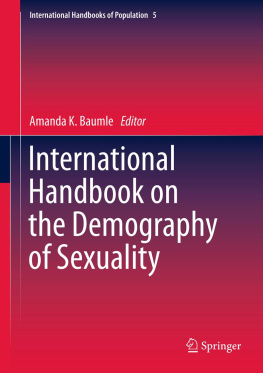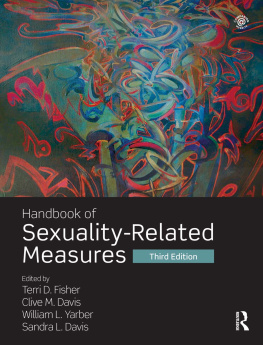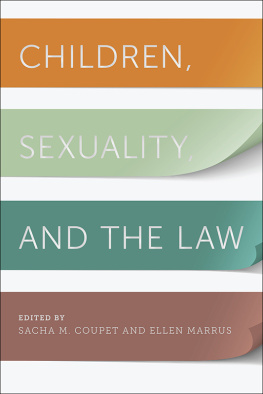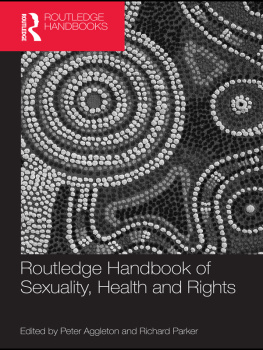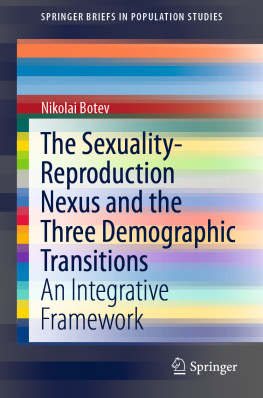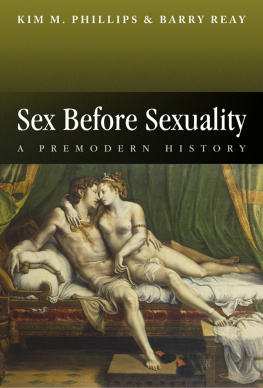Introduction
The field of demography has historically been slow to embrace research that addresses the heterogeneity of populations.). It is perhaps unsurprising then that demographic research has paid little attention to sexuality as a whole, or to sexual orientation in particular.
The majority of demographic articles that do mention some aspect of sexuality are those that focus on sexual behavior as it relates to sexually transmitted infections (e.g. Schiltz
More recent research, however, shows that sexuality affects demographic outcomes well beyond specific studies estimating the odds of contracting sexually transmitted infections (see e.g. Baumle and Poston ).
It is important, therefore, for demographers to consider the effects of sexuality on demographic factors, in addition to how sexuality intersects with other demographic characteristicssuch as sex and genderto shape outcomes. This handbook takes a step toward encouraging the incorporation of sexuality variables into demographic analyses, as well as demographic theory and models. In this introductory chapter, I provide a brief overview of the history of research on population sexuality, as well as explore what it would mean to formalize the development of the demography of sexuality. I conclude by highlighting the sections of this handbook and the topics covered herein.
A Brief History of Sex Research
Alfred Kinsey
In the early 1900s, sex research in the United States was very limited, focusing primarily on that of deviant sexual activities. Prohibitions on material of a sexual nature were to such a degree that it was unlawful to mail research surveys, or any other sexual material (Jones ). It was Alfred Kinsey who gained notoriety by encouraging the development of a methodical analysis of typical sexual behavior. Departing from a focus on the so-called deviant sexual experience, Kinsey explored the sexual behavior of married men and women in the United States, publishing two important works: Sexual Behavior in the Human Male (1948) and Sexual Behavior in the Human Female (1953).
Trained as an entomologist, Kinsey advocated detailed data collection and analysis when it came to human sexual behavior. To this end, his data were collected from thousands of individual sexual histories, in which Kinsey and his trained interviewers detailed sexual desires, behaviors, and identities from pre-pubescence onward (Jones ). This perspective was embraced by his successors, who were able to build upon the public dialogue about sexuality generated by Kinsey in order to further data collection efforts.
Beyond data collection, one of Kinseys most invaluable contributions to sexuality research concerns his seven point continuum regarding heterosexuality and homosexuality. In his analysis of sexual behaviors and desires, Kinsey emphasized individual variation. He did not ask individuals to simply identify as homosexual or heterosexual. Instead he questioned them on a broad range of behaviors and desires and then classified individuals along a continuum, with essentially heterosexual and essentially homosexual as the extreme ends of the scale (Kinsey on measurement of sexual identity, researchers today still grapple with the best way to capture this variation in sexuality on surveys and in interviews.
Two of Kinseys findings have particularly persevered over the years. The most notable, perhaps, is his estimate that approximately 10% of men are gay (Kinsey Nonetheless, these data contributed toward a reduction in the stigma associated with homosexuality by normalizing the behavior to a broader segment of the population.
In terms of female sexuality, Kinseys (), Kinseys work was some of the first to describe female sexuality in a manner beyond that of a passive participant in intercourse.
Kinseys research laid the groundwork for later demographic analyses of sexual behavior and desire. His contributions to both data collection and analysis for sexuality research lend merit to the assertions by Bullough () and others that after Kinsey, sex will never be the same.
Sex Research After Kinsey
Since Kinseys groundbreaking work, there have been huge strides made in sex research. Data collection on sexuality has increased with scientific inquiry being shaped both by methodological developments as well as social changes or crises which prompt additional collection. As Michaels and Giami (.
In the mid-1970s, Shere Hite conducted some of the most prominent studies of female sexuality. Published during the height of the womens movement, her Hite Reports were reflective of the periods focus on womens equality and sexual freedom. Advertising through womens magazines, Hite distributed essay questionnaires to women in order to gather data about the manner in which women themselves describe their sexuality (Weisstein
One of Hites ()? Her data collection, findings, and analysis are typified by the time period in which she was conducting her research, and raised questions regarding the manner in which sex researchers were (and should be) gathering data about sex.
In order to address health concerns that are linked to sexual behavior, such as HIV/AIDS, Edward Laumann and colleagues ( for further discussion).
Today, some of the most prominent sex-related surveys focus on gathering data about sexual identity and corresponding attitudes, behaviors, or characteristics. For example, data from the General Social Survey and the U.S. Census capture sexual identity that can then be used to examine questions regarding political/social attitudes, demographic characteristics, economic outcomes, and family composition. Given the pressing social and legal issues surrounding sexual minorities, data which are able to shed light on existing inequalities or provide greater understanding of the lives of LGB persons have garnered the greatest attention by academics and policymakers. Publications based on such data have been used, for example, to explore whether antidiscrimination laws are needed due to inequalities in income based on sexual orientation (see e.g. Baumle and Poston ).
The study of population sexuality is accordingly a constantly evolving field, with the quantity and content of data collected spurred on by broader changes in the public dialogue about sex. For demographers seeking to study sexuality at this point in time, the availability of data on sexual identity in nationally representative surveys permits new analyses of the extent to which sexual orientation affects traditional demographic outcomes. In the following section, I discuss some of the ways in which demographers might advance the discipline through consideration of sexuality.

